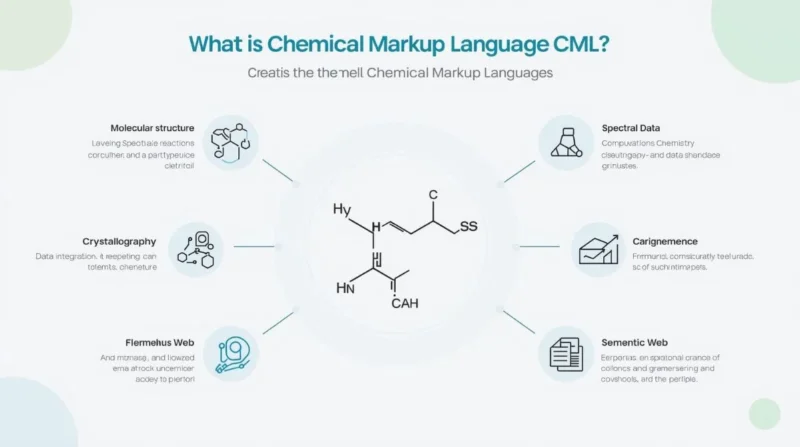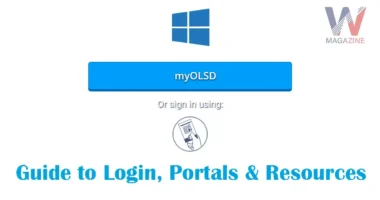Table of Contents
Chemical Markup Language (CML) is a specialized format for representing chemical data in a way that computers can easily understand. Think of it as a language that helps computers understand and share details about molecules, reactions, and other chemical data. It’s built on XML, a common format used to structure information so that both humans and machines can read it easily.
Why Do We Need CML?
In the past, chemists used various file formats to store chemical data. This made it hard to share and reuse information because different formats weren’t always compatible. CML solves this problem by providing a standard way to represent chemical data, making it easier to share, search, and analyze information across different platforms and tools.
What Can CML Describe?
CML is quite versatile. It can represent:
- Molecules: The structure and properties of individual molecules.
- Reactions: Details about chemical reactions, including reactants and products.
- Spectra: Information from techniques like NMR or IR spectroscopy.
- Crystals: Data about crystal structures.
- Computational Chemistry: Results from computer-based chemical simulations.
By covering these areas, CML helps chemists store and share a wide range of chemical information in a consistent format.
How Does CML Work?
CML uses tags, similar to those in HTML, to label different parts of chemical data. For example, a molecule might be enclosed in <molecule> tags, and each atom within it could be described with <atom> tags. This structured approach allows software to read and interpret the data accurately.
Here's a simple example: <molecule> <atom id="a1" elementType="H" x2="0.0" y2="0.0"/> <atom id="a2" elementType="O" x2="1.0" y2="0.0"/> <bond atomRefs2="a1 a2" order="1"/> </molecule>
In this snippet, we’re describing a water molecule with two atoms (hydrogen and oxygen) and a bond between them.
History of (CML): From XML Roots to Modern Applications
- CML was developed in the mid-1990s, based on XML (Extensible Markup Language).
- It aimed to standardize digital chemical data representation.
- Initially focused on molecules and reactions, later extended to spectra and more.
- Solved the issue of incompatible chemical file formats.
- Today, it powers modern chemical software, tools, and databases.
- Continues to evolve to support AI, machine learning, and FAIR data goals.
Tools That Support CML
Several software tools can read, write, and visualize CML files:
- Open Babel: A chemical toolbox that can convert between different file formats, including CML.
- Avogadro: A molecular editor and visualization tool that supports CML.
- Jmol: An open-source Java viewer for chemical structures in 3D.
- Chem4Word: A Microsoft Word add-in that allows users to insert and edit chemical information using CML.
These tools make it easier for chemists to work with CML files, whether they’re creating new data or analyzing existing information.
Benefits of Using CML
- Standardization: Provides a consistent format for chemical data, reducing confusion and errors.
- Interoperability: Makes it easier to share data between different software and researchers.
- Machine-Readable: Facilitates automated data processing and analysis.
- Extensibility: Can be expanded to include new types of chemical information as needed.
By adopting CML, the chemistry community can improve collaboration, data sharing, and the overall efficiency of research and development.
Applications of (CML)
Molecular Structure Representation
- CML stores atoms, bonds, coordinates, and charges in a structured format.
- Useful in drawing, analyzing, and sharing molecular models.
Chemical Reaction Modeling
- Represents reactants, products, conditions, and reaction mechanisms.
- Helps in simulating and predicting chemical behavior.
Spectral Data Storage
- Stores data from NMR, IR, UV-Vis, etc. in a readable format.
- Enables comparison and reuse of experimental results.
Crystallographic Information
- Describes crystal structures using CML tags.
- Used in material science and solid-state chemistry.
Computational Chemistry Results
- Saves outputs from simulations like energy levels, orbitals, etc.
- Makes results portable between different software tools.
Data Integration Across Platforms
- Acts as a bridge format between chemical databases and tools.
- Supports FAIR data exchange in collaborative research.
Chemical Publishing & e-Learning
- Used in academic journals, textbooks, and learning apps to display chemical info.
- Tools like Chem4Word let authors insert CML-based chemistry in Word documents.
Linked Data and Semantic Web
- Enables chemistry data to be connected with other scientific datasets online.
- Supports machine learning and AI-driven chemistry research.
Software Interoperability
- Used by tools like Open Babel, Avogadro, and Jmol for file conversion and visualization.
- Enhances compatibility across chemistry applications.
The Role of (CML) in FAIR Data and Open Science
- CML ensures data is Findable, Accessible, Interoperable, and Reusable (FAIR).
- It uses a standardized, machine-readable format to store chemical data.
- Supports easy sharing and integration of data across platforms.
- Enhances transparency and reproducibility in scientific research.
- Empowers Open Science by making chemical datasets open and useful globally.
- Encourages collaboration and data reuse in academic and industrial research.
(CML) in the Semantic Web: Linked Data for Chemistry
- CML allows chemical data to be linked across the web using Semantic Web principles.
- Data becomes machine-interpretable, allowing smarter searches and analysis.
- Enables integration of diverse chemical databases through common standards.
- Supports linked data frameworks, enhancing the utility of chemical information.
- Facilitates automated reasoning and data mining for advanced research.
- Helps in building intelligent chemistry platforms and digital lab ecosystems.
Conclusion
Chemical Markup Language is a powerful tool that brings structure and clarity to the way we handle chemical information. By using a standardized, computer-friendly format, CML enables better data sharing, analysis, and collaboration in the field of chemistry. Whether you’re a student, researcher, or professional, understanding and utilizing CML can enhance your work and contribute to the broader scientific community.









